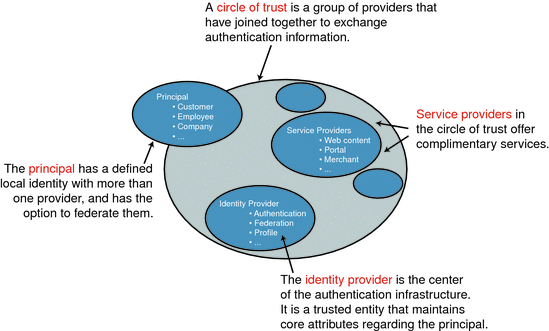How Federation Works
The goal of federation is to enable individuals and service providers to protect identity data while conducting network transactions across secure domains. When organizations form a trust agreement, they agree to exchange user authentication information using specific web technologies. The trust agreement would be among multiple service providers that offer web-based services to users and, at least, one identity provider (a service provider that maintains and manages identity information). Once metadata (a particular provider's federation configuration information) is exchanged and the trust is established technologically, single sign-on can be enabled between all the included providers, and users may opt to federate their multiple identities (depending on the protocol being used). In OpenSSO Enterprise, the trust agreement is virtually configured as a circle of trust using the console or command line interface. A circle of trust contains providers (service providers or identity providers) that are grouped together for the purpose of offering identity federation. Identity federation occurs when a user chooses to unite distinct service provider and identity provider accounts while retaining the individual account information with each provider. The user establishes a link that allows the exchange of authentication information between provider accounts. Users can choose to federate any or all identities they might have. After identity federation, when a user successfully authenticates to one of the service providers, access to any of the federated accounts within the circle of trust is allowed without having to reauthenticate. The following figure shows the subjects involved in federation.
Figure 9–1 Subjects Involved in an Identity Federation

-
A principal can have a defined local identity with more than one provider, and it has the option to federate the local identities. The principal might be an individual user, a group of individuals, a corporation, or a component of the Liberty architecture.
-
A service provider is a commercial or not-for-profit organization that offers a web-based service such as a news portal, a financial repository, or retail outlet.
-
An identity provider is a service provider that stores identity profiles and offers incentives to other service providers for the prerogative of federating their user identities. Identity providers might also offer services above and beyond those related to identity profile storage.
-
To support identity federation, all service providers and identity providers must join together into a circle of trust. A circle of trust must contain at least one identity provider and at least one service provider. (One organization may be both an identity provider and a service provider.) Providers in a circle of trust must first write trust agreements to define their relationships. A trust agreement is a contract between organizations that defines how the circle will work. For more information, see The Concept of Trust.
A travel portal is a good example of a circle of trust. Typically, a travel portal is a web site designed to help you access various travel-related services from one location. The travel portal forms a partnership with each service provider displayed on its web site. (This might include hotels, airlines, and car rental agencies.) The user registers with the travel portal which, in effect, is the identity provider for the circle of trust. After logging in, the user might click through to an airline service provider to look for a flight. After booking a flight, the user might click through to an accommodations service provider to look for a hotel. Because of the trust agreements previously established, the travel portal shares authentication information with the airline service provider, and the airline service provider with the accommodations service provider. The user moves from the hotel reservations web site to the airline reservations web site without having to reauthenticate. All of this is transparent to the user who must, depending on the underlying federation protocol, choose to federate any or all local identities. The following figure illustrates the travel portal example.
Figure 9–2 Federation Within a Travel Portal

- © 2010, Oracle Corporation and/or its affiliates
